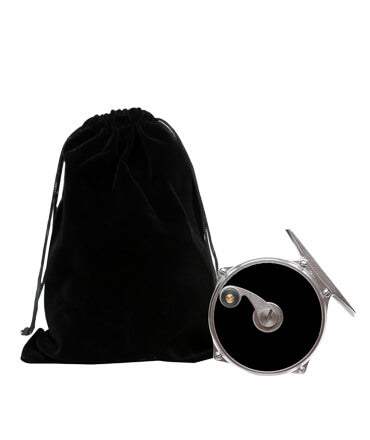Fly Reel: Understanding Drag Systems and Options for Deep Water Fishing
When I first started fly fishing, I quickly learned that the fly reel is not just a tool for retrieving line but a critical component that can influence my success on the water. Understanding the intricacies of the fly reel drag system can make all the difference, especially when battling larger fish or navigating challenging conditions.

As I explored the world of vintage fly reels, I began to appreciate their craftsmanship and history, which adds a unique charm to my collection. These classic reels often showcase innovations that were ahead of their time, making them appealing not just for use, but also as collectibles.
For those who venture into deep-water fishing, selecting the right fly reel is essential. I found that a reel with an extra spool offers flexibility and convenience, allowing me to switch lines effortlessly depending on the conditions. This adaptability can enhance any angler's fishing experience significantly.
Types of Fly Reels

In my exploration of fly reels, I have identified several key categories that help anglers select the right equipment for their needs. Each type offers unique features and advantages tailored to different fishing scenarios.
Understanding Fly Reel Drag Systems
The drag system on a fly reel is crucial for controlling fish during a fight. It allows for the controlled release of line under pressure, ensuring that a fish can strip line without breaking it.
I prefer drag systems that offer smooth performance and fine adjustments. There are two primary types: disc drag and click-and-pawl.
- Disc Drag: This system utilizes friction discs to provide a consistent drag pressure. It is suitable for larger fish and varied situations.
- Click-and-Pawl: Often found in vintage reels, this system uses a simple mechanical click to limit line speed. It offers a traditional feel but may lack the finesse of disc systems.
Choosing the right drag system enhances stability and performance during casting and retrieval.
Identifying Vintage Fly Reels
Vintage fly reels hold a unique charm and can also be functional in specific fishing situations. Often characterized by their craftsmanship, these reels are highly sought after by collectors and enthusiasts alike.
Key features to look for include:
- Material: Many vintage reels are made from high-quality metals, which contribute to their durability.
- Mechanism: A well-maintained click-and-pawl mechanism can still perform well today.
- Aesthetic: The classic design and patina can make these reels appealing for use or display.
While they may not match modern drag systems in performance, vintage reels can offer a nostalgic experience and often attract attention on the water.
Choosing a Fly Reel with Extra Spool
Using a fly reel with an extra spool can greatly enhance my versatility while fishing. Having multiple spools allows me to switch between different line types or weights with ease.
When selecting a reel, consider:
- Compatibility: Ensure the extra spool fits your reel model.
- Line Options: I prefer spools that can hold various fly lines, allowing me to adapt to different fishing conditions.
- Back-Up: An extra spool serves as a backup if something goes wrong with my main line.
This feature is particularly beneficial when fishing in diverse environments, from rivers to lakes.
Selecting a Fly Reel for Deep Water Fishing
For deep water fishing, I must choose a reel designed to withstand increased pressure and heavier lines. These reels typically feature a robust drag system for better control.
When evaluating options, I look at:
- Line Capacity: Ensure the reel can accommodate heavier backing and fly lines suited for deep water.
- Durability: A sealed drag system can prevent saltwater corrosion, enhancing longevity.
- Retrieve Ratio: Higher retrieve ratios allow for quicker line retrieval when fighting fish at depth.
Choosing the right reel can significantly affect my success in deep water fishing scenarios.
Fly Reel Mechanics and Design
In this section, I explore the critical components and design elements of fly reels that influence performance and usability. Key mechanics such as drag systems, arbor types, and the anti-reverse feature play essential roles in enhancing the angler's experience.
Examining Drag Systems in Detail
The drag system in a fly reel regulates the tension applied to the fishing line during a fight. It consists of a series of friction plates, washers, and sometimes springs, which engage when a fish pulls line. A smooth drag system provides stability, allowing controlled release without risking line breakage.
There are two main types of drag systems: click-and-pawl and disc drag. Click-and-pawl systems are simpler and often found in vintage reels, providing audible feedback but less control. Disc drag systems, prevalent in modern reels, use multiple friction surfaces for smoother, adjustable tension.
Effective drag systems allow the angler to adjust resistance quickly, adapting to fish behavior and size. This adaptability is crucial for successful catch-and-release fishing.
Arbor Types and Advantages
The arbor of a fly reel refers to the central spool around which the line is wound. It comes in two primary types: large arbor and standard arbor. Large arbor reels have a bigger spool diameter, allowing for faster line retrieval and less coiling, which enhances performance.
The advantages of a large arbor include reduced line memory and increased backing capacity. Additionally, they provide quick line pickup during high-action scenarios, which can be vital when fighting fast-moving fish.
On the other hand, standard arbor reels may offer a more classic feel and are often lighter. Choosing the right arbor type largely depends on fishing style and personal preference.
Anti-Reverse Feature
The anti-reverse feature prevents the handle from spinning backward, ensuring that the angler maintains control during critical moments. This feature is beneficial when applying pressure to the fish or navigating obstacles.
Most modern fly reels come equipped with a reliable anti-reverse mechanism, which enhances stability. A reliable anti-reverse ensures that momentum is directed effectively while fighting a fish, helping to avoid sudden line slack.
Incorporating this feature contributes to overall performance. It helps prevent potential break-offs during a fight when the line might otherwise snap back upon release.
Fly Line Management

Effective fly line management is crucial for successful fly fishing. It involves understanding how to handle line, ensure optimal performance, and prevent tangling or damage during casting and retrieval. Key components include backing, fly line types, and the knots used for connections.
Importance of Proper Backing
Backing serves as the foundation for your fly line. It allows for extra line capacity on the reel, particularly when targeting larger fish in deep water. I typically use a braided backing for its strength and low visibility in the water.
Attaching the backing to the reel properly ensures that the fly line remains secure during intense fights with fish. I often opt for a double uni knot to connect the backing to the fly line, providing a robust and reliable connection. Ensuring the right amount of backing is crucial; I recommend having at least two times the reel's capacity for larger species.
Fly Line Types and Selection
Selecting the right fly line directly influences casting efficiency and presentation. There are three primary types: floating, sinking, and intermediate lines. Floating lines are versatile and ideal for surface presentations, while sinking lines excel in deeper waters.
I find that matching the fly line to the environmental conditions makes all the difference. In slow-moving streams, a floating line with a leader and tippet works best. For deep water, a sinking line helps to reach fish that are less active near the surface. Additionally, I often consider the line's "belly" — the thicker middle section — to ensure smooth casting and turnover of flies.
Knots and Connections
The effectiveness of my fly fishing setup relies heavily on the knots I use. A strong connection is essential to prevent line failures during fights. The clinch knot is my go-to for attaching the fly to the tippet, known for its reliability and ease of tying.
For connecting the leader to the fly line, the loop knot provides flexibility, allowing the fly to move freely. Meanwhile, the nail knot is perfect for securing the backing to the fly line. I ensure my knots are snug and trimmed for optimal performance, reducing the chance of tangles or breakage while casting.
By understanding and implementing these components of fly line management, I can significantly enhance my fishing experience.











